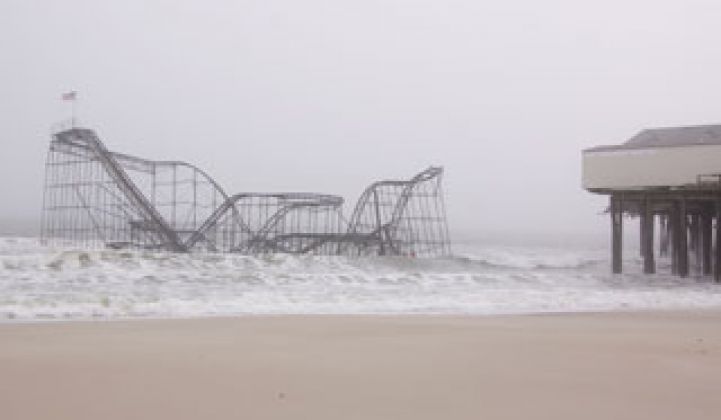Following in the footsteps of its tri-state neighbors, New Jersey is establishing an infrastructure bank that is focused on energy resiliency.
The names of these institutions vary across Connecticut, New York and New Jersey, but the idea is similar: leveraging public and private capital and the authority of the state to fund energy projects that provide cleaner, more reliable sources of electricity.
The $200 million for New Jersey’s Energy Resilience Bank will come from the state’s Community Development Block Grant-Disaster Recovery allocation. Unlike the models employed in Connecticut and New York, it remains unclear at what point private capital will be brought into New Jersey’s ERB, or at what scale.
The bank will support distributed energy resources at critical facilities, with an early focus on water and wastewater treatment plants. After Sandy, New Jersey determined that only 7 percent of its total wastewater capacity has distributed generation that can be islanded.
“A large number of plants in the state have no existing distributed generation, and many of these facilities are good candidates for combined heat and power or other technologies,” according to the state’s action plan amendment.
The action plan states that the benefits of technologies such as fuel cells, combined heat and power and resilient solar “are indisputable.” Hospitals, emergency response centers, town centers, transit networks and regional high schools that could be used as shelters could also be targets for the bank. Potential projects could include microgrids, distributed generation, smart grid technologies and energy storage.
“Distributed energy resources proved extremely resilient following Superstorm Sandy; unfortunately, due to high initial costs, many critical facilities do not have these energy resilience solutions in place,” Michele Brown, CEO of the New Jersey Economic Development Authority, said in a statement.
The report also calls for microgrids that could link various critical facilities to island in the case of another disaster like Sandy. The state and the U.S. Department of Energy are already working together on a microgrid, NJ TransitGrid, which will provide critical power to part of NJ Transit and Amtrak’s system.
New Jersey will also be able to learn from its neighboring states, which were also hit hard by Sandy and are further along in terms of issuing financing for microgrid projects. GTM Research’s Microgrid Deployment Tracker has found that several microgrid projects were initiated following an extreme weather event or a string of costly outages.
New York opened up a $40 million microgrid competition in January as part of its broader post-Sandy plan. Microgrids, particularly CHP-based microgrids, are just one technology that could also be funded by New York’s Green Bank, which is eventually expected to have a capitalization of $1 billion.
Connecticut has arguably the most sophisticated state-led microgrid pilot program, which is being implemented in cooperation with local utilities. The Northeast, driven by Connecticut, has the largest share of community microgrids of any region in the U.S., according to GTM Research’s recent report, North American Microgrids 2014: The Evolution of Localized Energy Optimization. With New Jersey’s resilience bank announcement, the region will likely continue to lead in community-based microgrids for years to come.
The New Jersey ERB will be helmed by Mitch Carpen, who was most recently at the Bank of Tokyo-Mitsubishi in Singapore. His deputy director will be Thomas Walker, who is currently the bureau chief of engineering services in the division of energy at New Jersey’s Board of Public Utilities. The guide to program funds, which will outline the parameters for issuing the grants and loans, will be issued by the end of summer.
***
For more on how resiliency has emerged as a framework for energy investment and how the power sector has responded, download the free e-book from Greentech Media, Resiliency: How Superstorm Sandy Changed America’s Grid.



